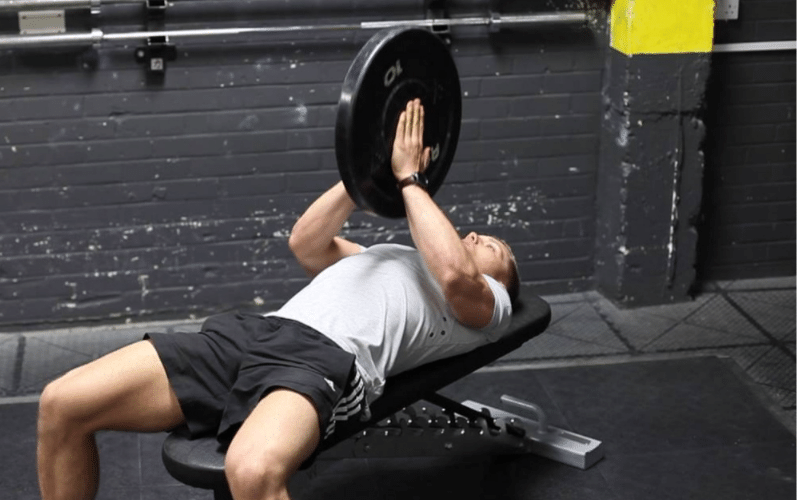Table of Contents

The Svend Press is an underrated training tool for your chest workouts. Start using it in your training immediately for huge gains.
It may seem like a minor movement, but the Svend press is a small shift that delivers enormous benefits.
Don’t be fooled by its modest and unimpressive appearance. Despite its simplicity and undeniable lack of flair, the Svend press is a tiny motion with significant effects.
Svend Press Muscles Worked
The Svend press is a chest muscle-building pressing movement. The following are the major muscles utilized in the Svend press motion:
Pectorals
The pectoral muscles (chest) are the main muscle groups that aid in the production of force for the Svend press.
While the Svend press is limited in range of motion when compared to a normal chest press, the chest muscles are still worked. (Just not as much as a normal bench press).
The high degree of muscular shortening and isometric tension that occurs at the top of a rep indicates that you will be able to lift it.
Secondary muscles worked:
- Middle deltoids
- Biceps
- Triceps
- Lats
- Core
Svend Press Benefits
More Chest Muscle
There’s nothing more frustrating than creating an amazing set of bench presses, only to hit the “triceps barrier,” where your pecs and shoulders barely feel fatigued, yet you just can’t lock out the next rep.
The smaller triceps muscles can be a limiting factor in pressing-heavy routines, although you may work around it by using specialized movements (the reverse-band incline press is one of my favorites).
The triceps frequently prevent you from excelling in pushing activities. If you are searching to boost muscular development, the Svend press is a fantastic choice since it doesn’t strain the triceps or shoulders muscles.
Joint Friendly
The rotator cuff’s minor muscles support the shoulder girdle, which often fatigues before the pectorals, shoulders, and triceps even when you follow good form.
A strained rotator cuff can slow down your progress in the short term and — in severe situations — result in a significant injury.
Increased Chest Muscles Recruitment
This is more important for bodybuilders than powerlifters, but it’s crucial when designing a strength training program.
This can lead to an under-developed chest and a lack of power in the bench press off the chest if not addressed with isolation movements.
How to Perform the Svend Press
The Svend Press appears to be a pushing movement on the surface, but if you give it a go, you’ll quickly discover that relying heavily on other muscle groups is nearly impossible. The following is a step-by-step guide on how to perform the Svend press.
Step 1 — Pinch the Plates
Take two 10-pound plates (or five-pound plates) and pinch them together firmly with both hands. Stand upright, keep your shoulder blades squeezed back, and hold the plates right up against your chest. Make sure you squeeze the plates tightly together.
Form Tip: In the setup posture, you should already be feeling your chest muscles working.
Step 2 — Press Upwards and Inwards
Continue to maintain the plates pressed firmly together, stretch your arms straight out and up until your elbows are fully locked out. At this point, your chest should be contracting hard enough to rival pain.
Form Tip: These aren’t something to be rushed. Keep in mind that you’ll be working with no more than 20 pounds at a time, so take your time and go slow and steady.
Svend Press with Dumbbells – In this variation, a dumbbell or even two may be used to perform the exercise. You may use more weight when you utilize dumbbells. It’s especially worthwhile and helpful while performing the work out prone.
Svend Press Kneeling – Kneeling on the ground for this version. You’ll utilize a lot less core muscles while kneeling on the floor. It will also help you keep your body more solid and rigid.
Cable Svend Press – In this case, you’ll be utilizing cables rather than other equipment. It may be done standing up, kneeling, seated, or even while recumbent.
Because the cables will always be straining to pull your hands apart, it adds a lot more resistance.
Incline Svend Press – On a 30 to 45-degree bench, you can do the decline variation. It will focus on your upper chest muscles and your front deltoids more.
Svend Press Alternatives
The following are three Svend press alternatives for coaches and athletes to increase chest strength and muscle growth.
Dumbbell Floor Press
The dumbbell floor press is a difficult chest press variation that may be used to target muscle imbalances, increase stability requirements. It allows for more personalized pressing angles if the athlete has difficulty with a fixed barbell position.
Spoto Press
The Spoto press is similar to the floor press and the board press, in that it entails pressing a barbell up towards your starting position without going all the way.
This floor press variation, which stops just above the chest, can improve a lifter’s shoulder stability and pressing balance in the press by strengthening the triceps, addressing sticking point deficiencies, and enhancing shoulder stability and pressing balance.
Floor Press with Chains/Bands
Although this barbell exercise is similar to other barbell pressing (and squatting/pulling) exercises, it can also be performed with chains and resistance bands.
Adding bands/chains to the barbell’s sides and placing approximately 60-70% of a lifter’s max on the bar (if the goal is speed-strength) can help increase overall strength, muscle, rate of force production, and improve press bar path.

